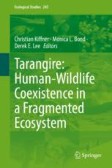Search
Search Results
-
Mitochondrial DNA diversity of the eastern black rhinoceros (Diceros bicornis michaeli) in Tanzania: implications for future conservation
There has been a drastic decline in the number of eastern black rhinoceros ( Diceros bicornis michaeli ) across Africa, leaving individuals restricted...

-
Ancient mitogenomes reveal a high maternal genetic diversity of Pleistocene woolly rhinoceros in Northern China
BackgroundWoolly rhinoceros ( Coelodonta antiquitatis ) is a typical indicator of cold-stage climate that was widely distributed in Northern...

-
ONT read assembly of the black rhino genome
ObjectivesThe black rhinoceros ( Diceros bicornis ) is an endangered mammal for which a captive breeding program is part of the conservation effort....
-
New materials of Pliorhinus ringstroemi from the Linxia Basin (Late Miocene, eastern Asia) and their taxonomical and evolutionary implications
A large collection of dicerorhine rhinoceros remains, here identified as Pliorhinus ringstroemi , were studied from the Late Miocene deposits of the...

-
Consideration of genetic variation and evolutionary history in future conservation of Indian one-horned rhinoceros (Rhinoceros unicornis)
BackgroundThe extant members of the Asian rhinos have experienced severe population and range declines since Pleistocene through a combination of...

-
RhODIS® (The Rhinoceros DNA Index System): The Application of Simple Forensic and Genetic Tools Help Conserve African Rhinoceros
All rhinoceros populations are under severe threat due to habitat encroachment and illegal hunting for their horns. Rhinoceros horn has been used for...
-
Gut microbiome architecture of wild greater one-horned rhinoceros: a vulnerable species from Kaziranga National Park, India
Rhinoceros unicornis , also known as the greater one-horned rhinoceros (GoHR), is a vulnerable wildlife species found in the Indian subcontinent with...

-
Genetic restoration of black rhinoceroses in South Africa: conservation implications
Globally, wildlife populations are becoming increasingly small and isolated. Both processes contribute to an elevated risk of extinction, notably due...

-
The First Find of Merck’s Rhinoceros (Mammalia, Perissodactyla, Rhinocerotidae, Stephanorhinus kirchbergensis Jäger, 1839) Remains in the Russian Far East
AbstractEnamel macro- and microstructure has been studied in the teeth of Merck’s rhinoceros ( Stephanorhinus kirchbergensis Jäger, 1839), woolly...

-
Exploring predators of Pacific salmon throughout their life history: the case of Japanese chum, pink, and masu salmon
When, where, and what predators prey upon salmon is fundamental to understanding their mortality in a given region. We reviewed the available...

-
Analysis of the Fauna and Bird Population of Urup Island and Adjacent Water Areas (Greater Kuril Chain)
Abstract —The ecological patterns of the formation of the fauna and bird population of the Urup Island were analyzed for the first time. The method of...
-
Past population control biases interpretations of contemporary genetic data: implications for future invasive Sitka black-tailed deer management in Haida Gwaii
Invasive species management practices often include genetic analyses to better inform decision-making and resource allocation. Yet, past management...

-
Small interannual variability in the body mass of a seabird with high flight costs
Seabird parents during chick rearing is hypothesized to regulate body mass to reduce flight costs and invest energy in current reproduction. Alcids...

-
On Time and Environment of Stephanorhinus kirchbergensis Jäger 1839 (Mammalia, Rhinoceratidae) in Altai and Northeastern Russia
AbstractThe remains of the extinct Merck’s rhinoceros ( Stephanorhinus kirchbergensis (Jäger 1839)), well studied in Western Europe, are rare in...

-
Seasonal space-use and resource limitation in free-ranging black rhino
The spatio-temporal distribution of forage and surface water shapes space-use for many herbivore species. Herbivores must make trade-offs between...
-
The Ecohistory of Tanzania’s Northern Rift Valley – Can One Establish an Objective Baseline as an Endpoint for Ecosystem Restoration?
Often conservationists suffer from the ‘shifting base line syndrome’. We illustrate this by elucidating the natural history of Tanzania’s northern...
-
Trends in the Biological Control of Horticultural Crop Pests in India
The encyrtid parasitoids Coccidoxenoides perminutus and Leptomastix dactylopii have been utilized for the control of citrus mealybug Planococcus...
-
The Role of Indigenous Food Species in Achieving Food Security in South-Eastern Nigeria
Food Security entails the availability of sufficient, nutritious and affordable food at all times to the population. Every country and region always...
-
The “Diahot Tooth” is a Miocene rhinocerotid fossil brought by humans to New Caledonia
The “Diahot Tooth” is an isolated postcanine tooth of a large herbivorous mammal, discovered in the Diahot region of northern New Caledonia in 1875....

